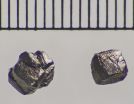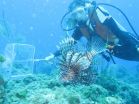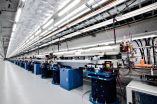Selenium compounds boost immune system to fight against cancer
2014-11-24
(Press-News.org) The immune system is designed to remove things not normally found in the body. Cells undergoing change, e.g. precursors of cancer cells, are therefore normally recognised and removed by the immune system. Unfortunately, the different cancer cells contain mechanisms that block the immune system's ability to recognise them, allowing them to freely continue cancer development.
Certain cancer cells overexpress immunostimulatory molecules in liquid form. Such over-stimulation has a negative impact on the immune system:
"You can say that the stimulating molecules over-activate the immune system and cause it to collapse, and we are, of course, interested in blocking this mechanism. We have now shown that certain selenium compounds, which are naturally found in, e.g., garlic and broccoli, effectively block the special immunostimulatory molecule that plays a serious role for aggressive cancers such as melanoma, prostate cancer and certain types of leukaemia," says Professor Søren Skov, Department of Veterinary Disease Biology, University of Copenhagen.
The new findings have just been published in the Journal of Biological Chemistry
Dissolved molecules
In this study, the researchers are focusing on the so-called NGK2D ligands. There are eight variants, of which one in particular has caught the researchers' attention, because it assumes liquid form. It is precisely the molecular dissolution that causes serious problems, once the cancer is raging. The entire bloodstream is, so to speak, infected, and the molecule is therefore used as a marker of serious illness:
"Molecules are found both on the surface of the cancer cells and dissolved in the blood of the affected person. We are now able to show that selenium compounds appear to have a very beneficial effect when it comes to neutralising the special variant of the NGK2D ligand - both in soluble form and when the molecule is placed on the cell surface," says Professor Søren Skov.
Better drugs in future
The researchers are constantly learning more about the disease mechanisms causing aggressive cancers in the skin, blood and reproductive organs:
"The overexpression seen in cancers such as melanoma, prostate cancer and certain types of leukaemia significantly impairs the immune system. If we can find ways to slow down the over-stimulation, we are on the right track. The new results are yet another small step towards better cancer drugs with fewer adverse effects," says Søren Skov.
Søren Skov's research team is part of a major EU project tasked with examining the potential for improving cancer treatment by boosting the immune system.
INFORMATION:
Contact:
Professor Søren Skov
Tel.: +45 35 33 31 26
ELSE PRESS RELEASES FROM THIS DATE:
2014-11-24
The degree to which parents sacrifice themselves for their children depends on a variety of factors. On the one hand nest predators pose a threat to the young and the parent birds. But also the time of hatching plays a role. Earlier studies have shown that birds born late in the season are more likely to be protected by their parents, as the adult birds often do not have the chance to produce replacement clutches. Older offspring also tend to be protected more readily than younger ones, as much more parental care and energy have already been invested.
"Studies on the ...
2014-11-24
Scientists have argued for half a century about the existence of a form of diamond called lonsdaleite, which is associated with impacts by meteorites and asteroids. A group of scientists based mostly at Arizona State University now show that what has been called lonsdaleite is in fact a structurally disordered form of ordinary diamond.
The scientists' report is published in Nature Communications, Nov. 20, by Péter Németh, a former ASU visiting researcher (now with the Research Centre of Natural Sciences of the Hungarian Academy of Sciences), together with ASU's ...
2014-11-24
CORVALLIS, Ore. - If you live in lionfish territory in the Atlantic Ocean, the last thing you want to be is a small fish with a long, skinny body, resting by yourself at night, near the bottom of the seafloor.
If so, your chances of being gobbled up by a lionfish increase by about 200 times.
Findings of a study on lionfish predation behavior, which may also apply to some other fish and animal species, have shed some new light on which types of fish are most likely to face attack by this invasive predator, which has disrupted ecosystems in much of the Caribbean Sea and ...
2014-11-24
Philadelphia, PA, November 24, 2014 - Pregnant women with diabetes are at an increased risk for many adverse birth outcomes. Preconception care (PCC) can significantly lower these risks by helping pregnant mothers with diabetes control their glucose levels, resulting in healthier babies and less money spent on complicated deliveries and lifelong medical complications. Effective, universal PCC for diabetic mothers could avert an estimated $5.5 billion in health expenditures and lost employment productivity over affected children's lifetimes, according to a new study published ...
2014-11-24
This news release is available in German.
X-ray flashes are a unique scientific tool. They are generated by accelerating electrons to very high energy levels in kilometer-long vacuum tubes, so-called linear accelerators, and then deflecting them with specially arranged magnets. In the process the particles emit X-ray radiation that is amplified until an ultra-short and intensive X-ray flash is released.
Researchers use these X-ray flashes to resolve structures as small as one ten billionth of a meter (0.1 nanometer) in size. That is roughly the diameter of a ...
2014-11-24
LA JOLLA, CA--November 24, 2014--A team led by scientists from The Scripps Research Institute (TSRI) has found a simple method to convert human skin cells into the specialized neurons that detect pain, itch, touch and other bodily sensations. These neurons are also affected by spinal cord injury and involved in Friedreich's ataxia, a devastating and currently incurable neurodegenerative disease that largely strikes children.
The discovery allows this broad class of human neurons and their sensory mechanisms to be studied relatively easily in the laboratory. The "induced ...
2014-11-24
ANN ARBOR--Our bones are smart. Bones know that by adolescence it's time to stop growing longer and stronger, and from that point on bones keep their shape by healing injuries.
This question of why bones grow longer and stronger in children, but stay static in adults--yet retain the ability to heal themselves, has long perplexed scientists in the bone regeneration field. But researchers from the University of Michigan, Kyoto University and Harvard University believe they may have unearthed a big piece of this puzzle.
The team discovered that a certain subset of cartilage-making ...
2014-11-24
VIDEO:
When zebrafish are infected with bright blue Mycobacterium marinum, bright red immune cells quickly surround the bacteria to form tightly organized nuggets called granulomas (vessels green, bacteria blue, immune cells...
Click here for more information.
DURHAM, N.C. -- The body responds to tuberculosis infection by locking the bacterial offenders into tiny clusters of immune cells called granulomas, which are a hallmark of the disease. This containment strategy succeeds ...
2014-11-24
The structure of pores found in cell nuclei has been uncovered by a UCL-led team of scientists, revealing how they selectively block certain molecules from entering, protecting genetic material and normal cell functions. The discovery could lead to the development of new drugs against viruses that target the cell nucleus and new ways of delivering gene therapies, say the scientists behind the study.
At the heart of every cell in our body is a cell nucleus, a dense structure that contains our DNA. For a cell to function normally, it needs to surround its nucleus with a ...
2014-11-24
The first detailed, high-resolution 3-D maps of Antarctic sea ice have been developed using an underwater robot. Scientists from the UK, USA and Australia say the new technology provides accurate ice thickness measurements from areas that were previously too difficult to access.
The results, published this week in the journal Nature Geoscience (Monday 24 November 2014), step up the pace of research in the polar regions aimed at understanding the dramatic sea ice changes in the context of climate change.
Scientists use a range of technologies and techniques to measure ...
LAST 30 PRESS RELEASES:
[Press-News.org] Selenium compounds boost immune system to fight against cancer






